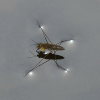dung beetle
Dung beetles feed almost exclusively on manure and navigate using the stars of the Milky Way. Some dung beetles burrow or tunnel and some simply live in dung. The behavior is common to many families of beetles.
For the Navajo or Diné, beetles, along with ants, dragonflies, bats and frogs, came into being during the First World or Dark World.










